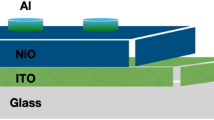Abstract
The temperature dependences of the specific contact resistance of silicon ρc with a doping step are measured experimentally and described theoretically. The measurements are performed in the temperature range from 4.2 to 380 K. It is established that the contacts of the studied Au–Ti–Pd–n+–n-Si structures are ohmic. It is shown that minimal ρc is implemented at T = 75 K. Its value rises both with a decrease in temperature (due to the freezing effect) and with an increase in temperature (due to the electron-enriched layer at the boundary with the bulk material). It is established that the bulk electron concentration strongly decreases in the near-contact region in a layer with a thickness on the order of one micron due to the compensation of silicon by deep acceptors appearing because of the formation of a rather high vacancy concentration during stress relaxation and the appearance of a high dislocation density, as well as due to their diffusion from the contact after heating to 450°C. The data on the occurrence of vacancy-type defects are confirmed by X-ray measurements. The dislocation density in the studied structures is also estimated from X-ray measurements.







Similar content being viewed by others
REFERENCES
S. M. Sze, Physics of Semiconductor Devices (Wiley, New York, 1981; Mir, Moscow, 1984), Vol. 1.
S. E. Swirhun and R. M. Swanson, IEEE Electron Dev. Lett. 7, 155 (1986).
D. K. Schroder, Semiconductor Material and Device Characterization, 3rd ed. (IEEE, Wiley, New York, 2006).
A. E. Belyaev, N. S. Boltovets, R. V. Konakova, Ya. Ya. Kudryk, A. V. Sachenko, and V. N. Sheremet, Semicond. Phys., Quantum Electron. Optoelectron. 13, 436 (2010).
A. V. Sachenko, A. E. Belyaev, V. A. Pilipenko, T. V. Petlitskaya, V. A. Anishchik, N. S. Boltovets, R. V. Konakova, Ya. Ya. Kudrik, A. O. Vinogradov, and V. N. Sheremet, Semiconductors 48, 492 (2014).
U. M. Kulish and A. P. Vyatkin, Izv. Vyssh. Uchebn. Zaved., Fiz. 6, 157 (1965).
A. E. Belyaev, V. N. Bessolov, N. S. Boltovets, Yu. V. Zhilyaev, V. P. Klad’ko, R. V. Konakova, A. V. Kuchuk, A. V. Sachenko, and V. N. Sheremet, Physical and Technological Problems of Nitride Gallium Electronics (Nauk. Dumka, Kiev, 2016) [in Russian].
N. S. Davydova and Yu. Z. Danyushevskii, Diode Generators and Microwave Amplifiers (Radio Svyaz’, Moscow, 1986) [in Russian].
N. S. Boltovets, V. V. Kholevchuk, R. V. Konakova, V. F. Mitin, and E. F. Venger, Sens. Actuators, A 92, 191 (2001).
V. N. Alfeev, Semiconductors, Superconductors and Paraelectrics in Cryoelectronics: Properties and Applications in Cryoelectronic Integrated Circuits and Devices of Structures Based on Contacts of Semiconductors, Superconductors and Paraelectrics (Sov. Radio, Moscow, 1979) [in Russian].
A. E. Belyaev, N. S. Boltovets, V. P. Klad’ko, R. V. Konakova, O. I. Lyubchenko, A. V. Sachenko, N. V. Safryuk, V. V. Shinkarenko, V. A. Pilipenko, T. V. Petlitskaya, A. A. Khodin, and P. N. Romanets, in Proceedings of the 6th International Conference on Structural Relaxation in Solids, Vinnitsa, Ukraina, 2018, p. 213.
V. P. Klad’ko, L. I. Datsenko, J. Bak-Misiuk, S. I. Olikhovskii, V. F. Machulin, I. V. Prokopenko, V. B. Molodkin, and Z. V. Maksimenko, J. Phys. D: Appl. Phys. 34, A87 (2001).
R. K. Kupka and W. A. Anderson, J. Appl. Phys. 69, 3623 (1991).
G. Brezeanu, C. Cabuz, D. Dascalu, and P. A. Dan, Solid State Electron. 30, 527 (1987).
D. K. Ferry, Phys. Rev. B 14, 1605 (1976).
A. V. Sachenko, A. E. Belyaev, N. S. Boltovets, R. V. Konakova, Ja. Ja. Kudryk, S. V. Novitski, V. N. Sheremet, J. Li, and S. A. Vitusevich, J. Appl. Phys. 111, 083701 (2012).
B. I. Boltaks, M. K. Bakhadyrkhanov, S. M. Gorodetskii, and G. S. Kulikov, Compensated Silicon (Nauka, Leningrad, 1972) [in Russian].
M. S. Yunusov, Physical Phenomena in Silicon Doped with Platinum Group Elements (FAN, Tashkent, 1983) [in Russian].
Physics and Material Science of Semiconductors with Deep Levels, Ed. by V. I. Fistul’ (Metallurgiya, Moscow, 1987) [in Russian].
V. I. Fistul’, Introduction to Semiconductor Physics (Vyssh. Shkola, Moscow, 1984) [in Russian].
R. Smith, Semiconductors (Cambridge Univ. Press, Cambridge, 1959).
B. I. Boltaks, Diffusion and Point Defects in Semiconductors (Nauka, Leningrad, 1972) [in Russian].
S. S. Gorelik and M. Ya. Dashevskii, Material Science of Semiconductors and Insulators (Metallurgiya, Moscow, 1988) [in Russian].
V. T. Bublik, S. Yu. Matsnev, K. D. Shcherbachev, M. V. Mezhennyi, M. G. Mil’vidskii, and V. Ya. Reznik, Phys. Solid State 45, 1918 (2003).
K. Ravi, Imperfections and Impurities in Semiconductor Silicon (Wiley, New York, 1981).
V. S. Vasil’ev, V. F. Kiselev, and B. N. Mukashev, Defects in the Bulk and at the Surface of Silicon (Nauka, Moscow, 1990) [in Russian].
M. G. Mil’vidskii and V. B. Osvenskii, Structural Defects in Single Crystal Semiconductors (Metallurgiya, Moscow, 1984) [in Russian].
A. Dargys and J. Kundrotas, Handbook on Physical Properties of Ge, Si, GaAs and InP (Science and Encyclopedia, Vilnius, 1994).
Author information
Authors and Affiliations
Corresponding author
Additional information
Translated by N. Korovin
Rights and permissions
About this article
Cite this article
Belyaev, A.E., Boltovets, N.S., Klad’ko, V.P. et al. Features of the Temperature Dependence of the Specific Contact Resistance of Au–Ti–Pd–n+–n-Si Diffusion Silicon Structures. Semiconductors 53, 469–476 (2019). https://doi.org/10.1134/S1063782619040055
Received:
Revised:
Accepted:
Published:
Issue Date:
DOI: https://doi.org/10.1134/S1063782619040055




